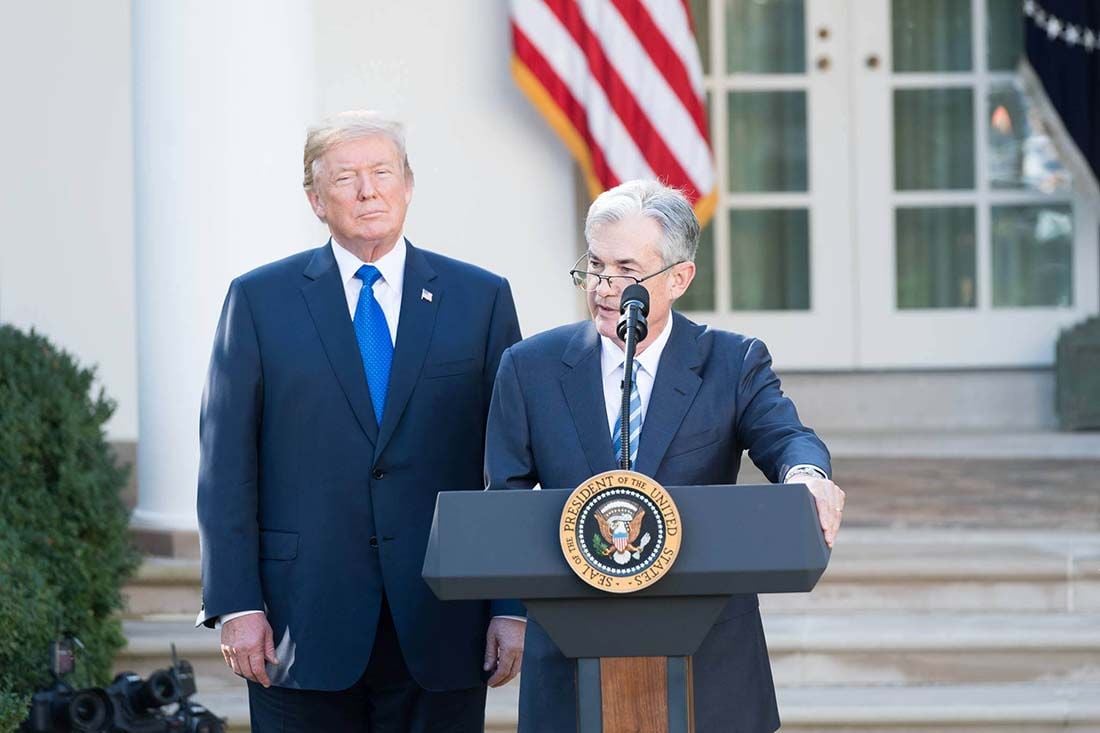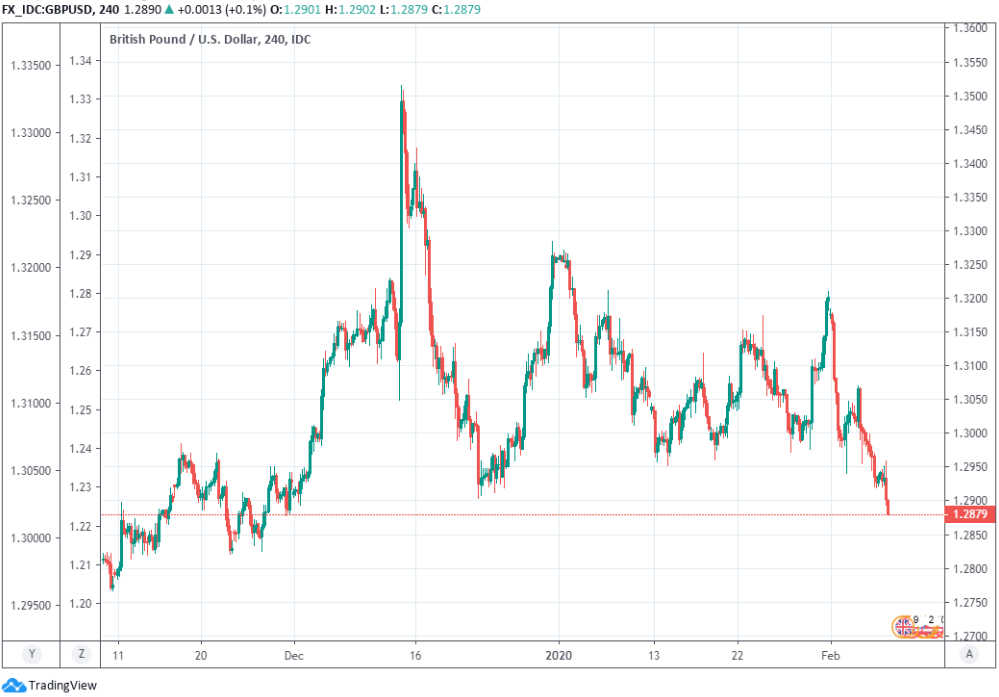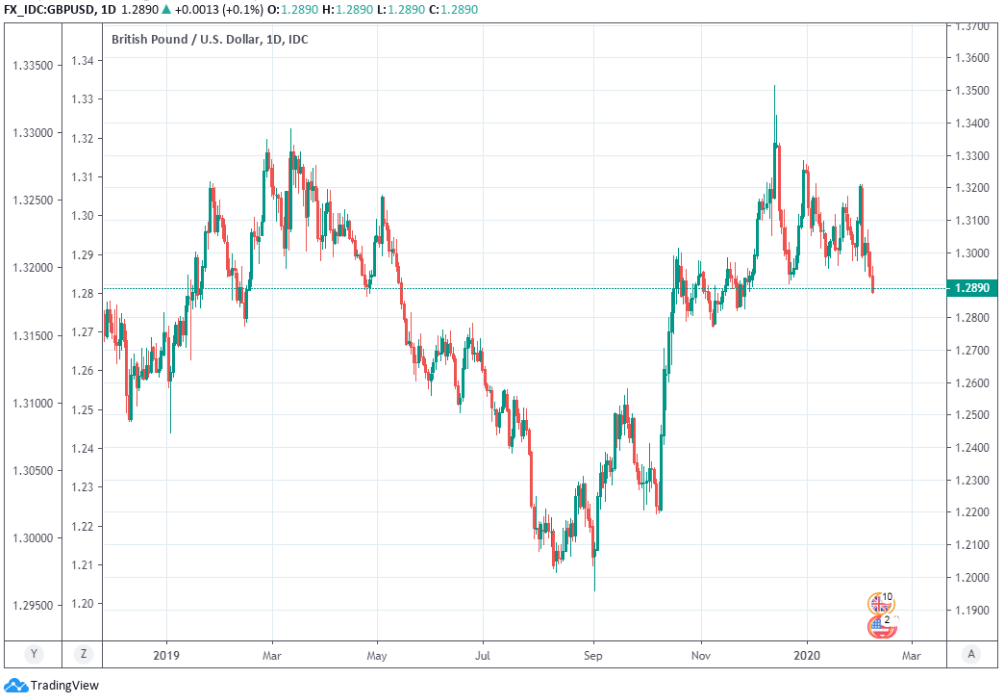Pound-Dollar Week Ahead: Condemned to More Losses by Bearish Technical Developments
- Written by: James Skinner
- GBP/USD breaks decisively below 1.29 ahead of last week's close.
- Weekly close below 1.29 condemns GBP to more losses this week.
- 1.2700 level widely tipped as the next destination for the GBP/USD.
- GBP eyes Q4 growth data this week, could matter for BoE outlook.
- USD to strengthen further on growth performance, virus concerns.

© The White House
- GBP/USD Spot rate: 1.2868, down 2.4% last week
- Indicative bank rates for transfers: 1.2537-1.2627
- Transfer specialist indicative rates: 1.2695-1.2772 >> Get your quote now
The Pound fell and closed below a key support level against the Dollar on Friday in a bearish technical development that could now see it slide back toward October 2019 levels over the coming days.
Sterling was the worst performing major currency last week amid confrontational rhetoric that's revived the market’s ‘no deal’ Brexit concerns at a point when prior gains had left the British currency vulnerable to a correction.
Dollar strength, driven by U.S. economic outperformance and occasional bouts of risk aversion in the wider market, was also at play too and will remain important factors in the days ahead. Especially as the coronavirus death toll surpassed that of 'SARS' over the weekend as the deadly disease shows little sign of slowing in its damaging spread within the world's second largest economy, which has all but come to a standstill these last two weeks as officials lock down entire cities in order to fight the infection.
This combination of Sterling weakness and Dollar strength has taken the Pound-to-Dollar rate below the 1.29 level that's widely regarded as the last technical defence of the late-2019 uptrend.
1.2905 is the lower end of a resistance pocket that barred the path higher for Sterling on several occasions in the second half of 2019 however, and in keeping with technical convention, that level converted from resistance to support once it was overcome in response to Prime Minister Boris Johnson’s October declaration that he’d agreed exit terms the EU.
And in keeping with that earlier experience, the level has provided Sterling with strong support twice since the early days of October, although its now been broken amid a strengthening of the U.S. Dollar and ‘no deal’ Brexit risks that look set to again tar the outlook for British exchange rates.
“We acknowledge that this support is exposed. Failure at 1.2905 would put the 55-week ma at 1.2805 and the 200-day moving average at 1.2694 back on the plate,” says Karen Jones, head of technical analysis for currencies, commodities and bonds at Commerzbank in a Friday note to clients.
Above: Pound-to-Dollar rate shown at 4-hour intervals.
Friday’s price action saw the Pound-to-Dollar rate risking a move below 1.29 from the get-go although after a brief and ill-fated climb in the morning hours the British currency broke down again ahead of the weekend.
Pound Sterling’s extension to the downside came in the wake of a strong January non-farm payrolls report from the U.S., which has further burnished the already-improving credentials of an exceptionalist U.S. economy.
Short EURUSD and GBPUSD on yesterday’s breaks of important support (1.1000 and 1.3000 respectively), targeting 1.0900 for EURUSD and 1.2750 or lower for GBPUSD,” says John Hardy, head of FX strategy at Saxo Bank.
Transatlantic economic divergence will further entrench and already steep interest rate differential that’s rendered the Dollar the only game in town for yield hungry investors, with the smaller Canadian Dollar being the only exception.
That’s bad news for low-yielding currencies in general, but especially those that could be subjected to rate cuts in the months ahead - like the Pound.
Above: Pound-to-Dollar rate shown at Daily intervals.
Saxo Bank's Breakout Monitor identified Sterling as a good candidate for short-selling earlier this week while Hardy advocated on Thursday that clients bet on a fall from 1.2960 to 1.2710. A bet that’s paying off handsomely so far.
The bank also has a bullish view of the U.S. Dollar across the board and is growing concerned about the outlook for commodity prices in light of the coronavirus outbreak and uncertainty, if not outright doubt, about the reliability of China's disclosures on the matter.
Coronavirus concerns have the capacity to foster risk aversion among investors, which would always benefit the safe-haven Dollar at the expense of the Pound.
China’s National Health Commission declared a total of 811 deaths at the weekend, taking the tally above the 774 who died from the Severe-Acute-Respiratory-Syndrome (SARS) in 2002-2003. There are now 37,198 confirmed cases of the disease in China, up from 14,380 at midnight on February 01.
AA
Pound Sterling: What to Watch
Sterling was the worst performer last week and now faces downside risks against the Euro and Dollar from both the charts and the fundamental side, which will be back in focus with this week's release of final quarter GDP data.
Tuesday at 09:30 marks the release of December GDP figures that are themselves the final piece of a so-far dire fourth quarter puzzle.
Consensus looks for a 0.2% December increase to leave GDP unchanged for the final quarter, which would mark not only a limp rebound from the prior contraction but also a weak finish to a terrible year.
The economy grew 0.1% in October before contracting a sharp 0.3% in November as retail sales shrank even in spite of the Black Friday promotions that are normally a consumer frenzy, while the Brexit-transfixed manufacturing sector offered little support.
"The balance between improving domestic activity and potential hardening negotiations should keep GBP/USD in an effective 1.28-1.32 range," says Tim Riddell, a London-based strategist at Westpac.
November’s data showed the economy growing just 0.6% for the year to the end of that month and Tuesday’s figures could confirm an almost-as-dire picture even if growth does rebound by the 0.2% anticipated.
Such a picture would be problematic for the Pound because it would leave the economy growing beneath its estimated 1% inflation-producing rate of growth at a time when the consumer price index of 1.3% is far below the 2% target.
These growth and price dynamics argue for a Bank of England (BoE) interest rate cut and only some offsetting stimulus, possibly from the March 11 budget, could undermine the case for policy support in the short-term.
"Next week’s GDP data will be important for the MPC. If our estimates are correct, a negative Q4 print won’t just be symbolic (i.e. another contraction) - it will have ramifications for the MPC’s forecasts, which are predicated on a flat reading next week," says Sanjay Raja, an economist at Deutsche Bank. "Positive payback in services and manufacturing activity should support monthly output. Colder weather and heavy precipitation should also see energy and water activity rise. We do, however, anticipate a drop in construction output."
The BoE itself eschewed a rate cut last month because in the aftermath of December’s election it saw scope for an economic recovery in the months ahead, with the decision leading investors to price-out from the market the prospect of a rate cut coming before September. However, a worse than expected growth performance for the final quarter could lead some investors to question that assumption, with implications for Sterling.
U.S. economic data including January retail sales and inflation figures will also be important not only for the Dollar this week but for all other exchange rates because, with the U.S. economy again demonstrating its exceptionalist credentials while the UK and Eurozone economies struggle, the Dollar’s existing interest rate advantage over most of its rivals is becoming further entrenched.
AA
The Dollar: What to Watch
The Dollar was the second best performing major currency last week after the U.S. economy reminded investors repeatedly of its exceptionalist credentials which are not only entrenching a substantial interest rate advantage over the greenback’s rivals, but also threatening to boost the currency again this week.
Thursday and Friday will see inflation and retail sales figures released for the month of January and given multiple recent signs of a New Year acceleration in the world’s largest economy, markets will scrutinise the data closely for further signs of outperformance.
Consensus is looking for the annual rate of inflation to have ticked higher from 2.3% to 2.4% last month although the more important core rate of price growth is seen slipping lower from 2.3% to 2.2%.
Meanwhile, retail sales are seen growing by a steady month-on-month pace of 0.3%, although growth in the more important ‘core’ measure is expected to have slipped from 0.7% in December to 0.14% last month.
“January data have taken on a more positive tone. The ISM surveys point to solid goods and services output, while January employment rose 225k,” says Michael Gapen, chief U.S. economist at Barclays. “We look for a modest 0.2% m/m rise in core retail sales, following a strong increase in December...We expect a solid increase in core CPI to have been offset to some extent by softness in energy and food prices. For core CPI, excluding food and energy, we forecast an increase of 0.2% m/m and 2.3% y/y.”
The Dollar has recoiled against many major currencies since Wednesday and has increasingly cut short an earlier rally in so-called risk assets since mid-week, given further signs of renewed divergence between the U.S. economy and those elsewhere in the world.
That curtailment was most evident in Australian Dollar exchange rates Friday although concerns about the outlook for the global economy have been best highlighted by price action in the Euro-to-Dollar rate, which has broken decisively to the downside from a four-month trading range this week.
Growth divergence between the U.S. and the rest of the world threatens to further entrench the Dollar’s interest rate advantage over other currencies. That advantage is a rate differential that reaches close to 2% against some currencies, making the Dollar attractive as well as expensive to wager against.
“There doesn’t appear to be much in the way of further [Dollar Index] upside, we revise up upside target from 98.0-98.5 to 99.0 on 1mth horizon; US data surprise indices are at cycle lows and OIS markets price in an (excessive?) 45% probability of an FOMC cut by 29 April,” says Richard Franulovich, head of FX strategy at Westpac. "US has a smaller direct trade exposure to China than many others. An impressive array of key US data have been reassuringly upbeat too, including ISM surveys, ADP payrolls and durable orders."
Euro-to-Dollar woes explain a sizeable portion of gains in the Dollar index for this week as well as for 2020, with the Euro down 2.22% over the last month while the Dollar Index has climbed 2.28%.
The Euro has a more-than 50% weighting in the benchmark of the U.S. currency, although Pound Sterling has around a 10% share so losses for the British currency can also aid the greenback meaningfully.
“The most significant driver in global markets remains coronavirus developments. Specifically investors are looking closely at the pace of new infections, for signs of any effective treatments and what measures the authorities and the private sector are taking to limit the outbreak. We will be looking for clues on the scale of the impact on the economy,” says Philip Shaw, chief economist at Investec. “The Democratic New Hampshire primary takes place on Tuesday. Joe Biden needs to put in a better performance there than in Iowa to prevent losing excessive momentum, although next week’s results may overstate underlying support for Bernie Sanders.”
Other key factors for the Dollar in the week ahead include developments in the spread of coronavirus both inside and outside the borders of China, as well as the Democratic Party process for choosing its 2020 presidential candidate.
Coronavirus concerns have the capacity to foster risk aversion among investors, which would always benefit the safe-haven Dollar at the expense of the Pound and all other major currencies except the Japanese Yen and Swiss Franc.
“Coronavirus developments remain in full focus but the poor performance of Joe Biden this week in Iowa does point to greater risks of a Bernie Sanders victory. That though might not disrupt USD sentiment if President Trump’s approval ratings and probability of winning in November rise. We expect politics to begin to gain more focus in the markets. National polling on Sanders v Trump will prove most important,” says Lee Hardman, a currency analyst at MUFG.






